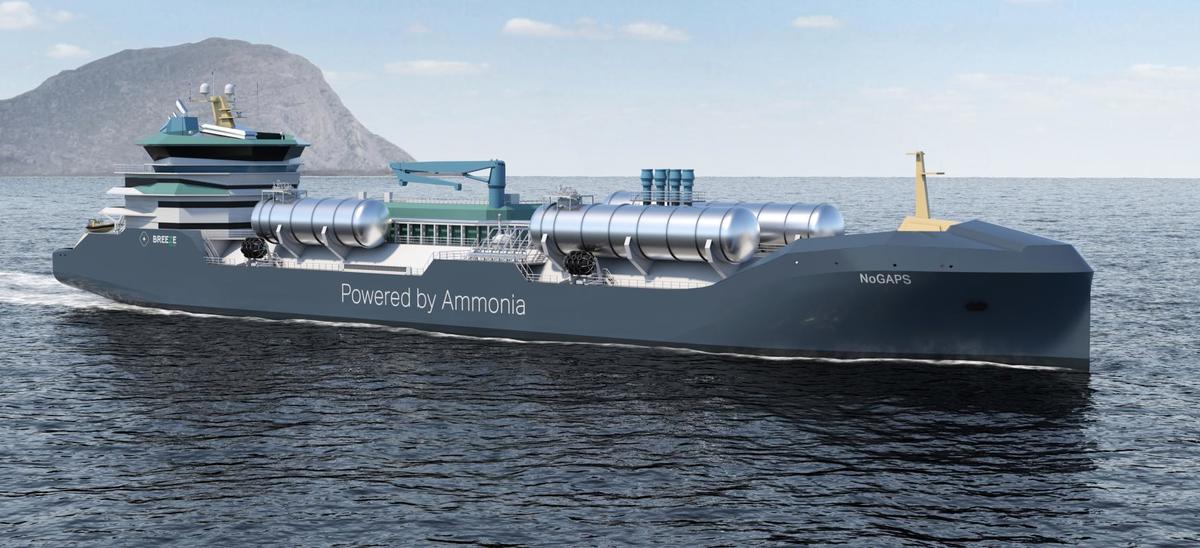The Week in Alt Fuels: Who pays for a green gas leak?
The absence of an IMO liability framework for using gaseous marine fuels for bunkering could create legal uncertainty and complicate compensation claims in offshore accidents.
 CONCEPT: Ammonia-powered vessel. Nordic Innovation
CONCEPT: Ammonia-powered vessel. Nordic Innovation
It will be hard to insure nuclear-powered ships because you can't insure against things like radiation exposure or damage from nuclear waste, marine insurer NorthStandard recently said. The International Maritime Organisation (IMO) lacks a global liability convention for nuclear-powered ships, which will instead be covered by regional or national laws.
This can increase uncertainty over liability and financial exposure. Insurers would then struggle to assess risks, making reinsurance either prohibitively expensive or unavailable.
This raises a critical question: who would be financially responsible for a leak involving gaseous alternative marine fuels like LNG, ammonia or hydrogen?
In a report last year, the UK Protection & Indemnity (P&I) Club warned that liability issues arising from alternative fuel leaks. For starters, the challenge isn’t just legal, it’s fundamentally different from an oil spill. Unlike oil, which leaves a visible slick, LNG, ammonia or hydrogen could disperse as toxic or flammable gas clouds and endanger crew, port workers and nearby communities.
According to UK P&I, existing IMO conventions, such as the Civil Liability Convention for Oil Pollution Damage and the 2001 Bunkers Convention, only apply to hydrocarbon oil pollution. Gaseous fuels do not yet have a clear liability and compensation regime under international law.
In oil spill cases, claimants benefit from "strict liability", meaning compensation is available regardless of fault. Insurers are directly liable, ensuring victims receive compensation even if the shipowner cannot pay. Economic losses, such as port closures or shipping delays, are also covered under existing frameworks.
With alternative fuels, these protections may not apply. Compensation would depend on local laws, which vary across jurisdictions, potentially requiring claimants to prove negligence before seeking damages. Direct claims with insurers may not be possible because established frameworks don't exist. Economic losses might not be recoverable unless they are tied to physical damage, further complicating compensation claims for those affected by an alternative fuel leak.
“If this gap in international law persists, issues related to the use of gaseous marine fuels will likely be governed by a patchwork of domestic laws,” UK P&I noted. This “fragmentation” could create legal uncertainty for shipowners and pollution victims, leading to inconsistent compensation rulings depending on where an incident occurs, it added.
The Global Maritime Forum (GMF) pointed out that alternative fuels introduce new risks, including increased explosivity, flammability and corrosivity. And currently there is no international regulation in force to specifically address liability for these fuels.
Take ammonia, for example. According to GMF, an ammonia leak could result in pollution claims and personal injury lawsuits. But it would not be covered by the Civil Liability Convention when it is carried as cargo, or by the Bunkers Convention if it is used as a marine fuel. The Wreck Removal Convention would only apply if the leak comes from a shipwreck. And the Limitation of Liability for Maritime Claims does not impose strict liability or mandate insurance coverage for ammonia as a bunker fuel.
A lack of historical data on these alternative fuels presents a major challenge, according to Lynn Loo of the Global Centre for Maritime Decarbonisation.
“With ammonia, we’re dealing with a new fuel that hasn’t been used before. So, where does one get the data to assess risks?” she said.
Without clear risk assessments, insurers may hesitate to provide coverage or charge prohibitively high premiums, potentially slowing investments in green fuels.
The IMO and its member states are currently focussed on developing mid-term greenhouse gas (GHG) reduction measures and other regulatory guidelines for alternative fuels. The industry must also prioritise the creation of international liability conventions for alternative bunker fuels. Without clear legal frameworks, the financial burden of a leak could remain an open – and costly – question.
In other news this week, the European Commission proposed a Clean Industrial Deal action plan to prioritise domestic production of green fuels and technologies. At least €100 billion ($105 billion) could be mobilised through national and EU-level Emissions Trading System allowances, and by reducing red tape around permitting, investment approvals and regulatory processes.
At the IMO, 61 out of 109 member states that have ratified MARPOL Annex VI now endorse a universal GHG levy. A group of 15 countries, including Saudi Arabia, Brazil, Oman, South Africa and China, have refused to back the levy. Apart from discussions around the levy, there is “zero progress on the global fuel standard”, Constance Dijkstra, IMO policy manager at Transport & Environment said.
Swiss engine maker Winterthur Gas & Diesel (WinGD) has debuted its first methanol dual-fuel engine. The engine is intended for a 16,000 TEU container ship, but the company has not provided any more details about the vessel, including its owner or construction timeline.
Italian energy firm Eni wants to build an integrated green hydrogen and bio-methanol bunker fuel production plant at its refinery in Pavia, Italy. The proposed plant will have capacity to produce 110,000 mt/year of bio-methanol by synthesising around 200,000 mt/year of organic waste as feedstock.
By Konica Bhatt
Please get in touch with comments or additional info to news@engine.online





